length MAZDA MODEL CX-9 2010 Owners Manual (in English)
[x] Cancel search | Manufacturer: MAZDA, Model Year: 2010, Model line: MODEL CX-9, Model: MAZDA MODEL CX-9 2010Pages: 592
Page 33 of 592
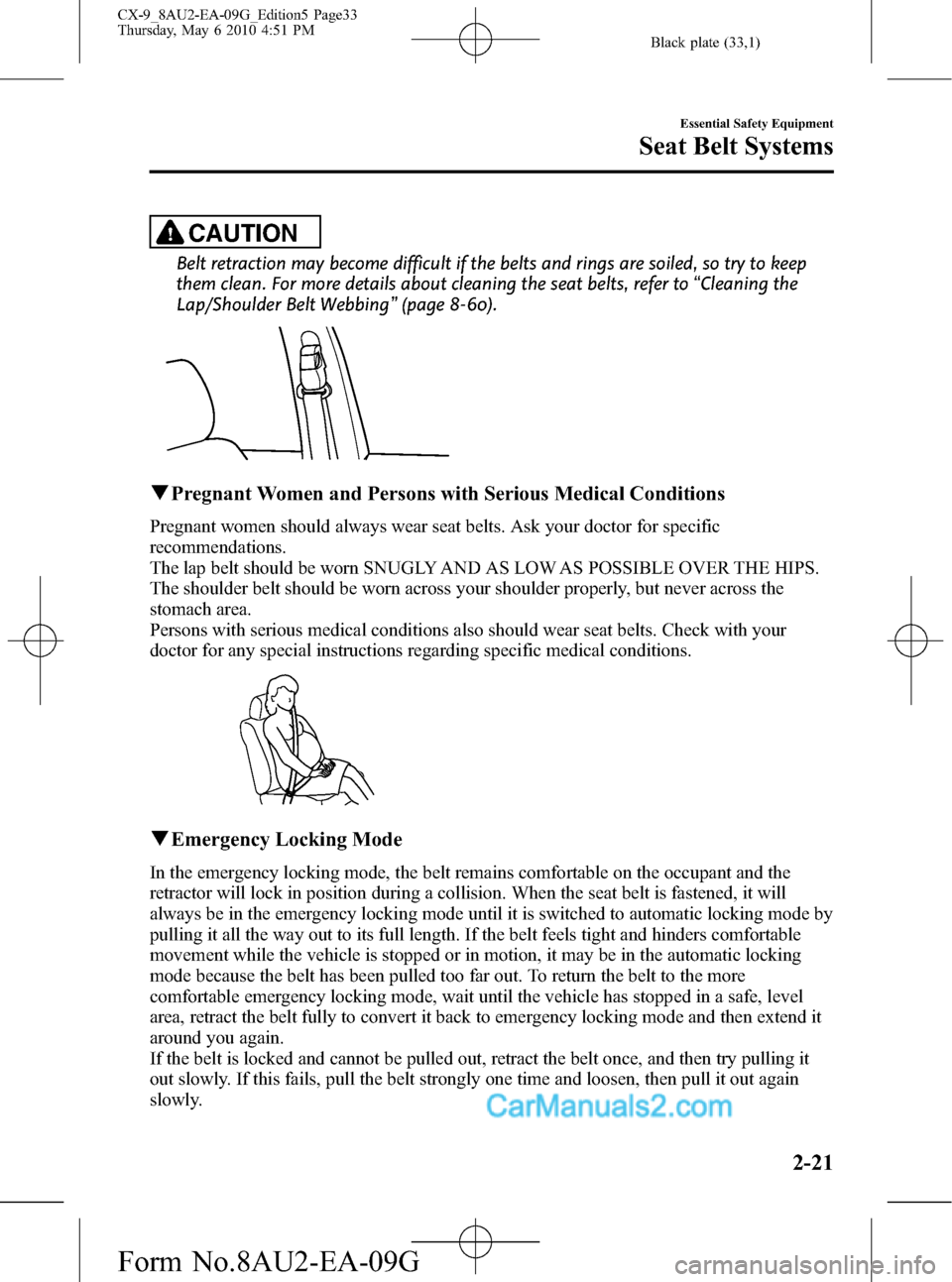
Black plate (33,1)
CAUTION
Belt retraction may become difficult if the belts and rings are soiled, so try to keep
them clean. For more details about cleaning the seat belts, refer to“Cleaning the
Lap/Shoulder Belt Webbing”(page 8-60).
qPregnant Women and Persons with Serious Medical Conditions
Pregnant women should always wear seat belts. Ask your doctor for specific
recommendations.
The lap belt should be worn SNUGLY AND AS LOW AS POSSIBLE OVER THE HIPS.
The shoulder belt should be worn across your shoulder properly, but never across the
stomach area.
Persons with serious medical conditions also should wear seat belts. Check with your
doctor for any special instructions regarding specific medical conditions.
qEmergency Locking Mode
In the emergency locking mode, the belt remains comfortable on the occupant and the
retractor will lock in position during a collision. When the seat belt is fastened, it will
always be in the emergency locking mode until it is switched to automatic locking mode by
pulling it all the way out to its full length. If the belt feels tight and hinders comfortable
movement while the vehicle is stopped or in motion, it may be in the automatic locking
mode because the belt has been pulled too far out. To return the belt to the more
comfortable emergency locking mode, wait until the vehicle has stopped in a safe, level
area, retract the belt fully to convert it back to emergency locking mode and then extend it
around you again.
If the belt is locked and cannot be pulled out, retract the belt once, and then try pulling it
out slowly. If this fails, pull the belt strongly one time and loosen, then pull it out again
slowly.
Essential Safety Equipment
Seat Belt Systems
2-21
CX-9_8AU2-EA-09G_Edition5 Page33
Thursday, May 6 2010 4:51 PM
Form No.8AU2-EA-09G
Page 43 of 592

Black plate (43,1)
NOTElTo encourage rear seat passengers to wear
their seat belts, we suggest leaving the
center-rear lap position of the belt fastened
at all times except when folding the rear
seat forward.
lPulling the seat belt all the way out will
switch it to automatic locking mode. If
automatic locking mode is not needed,
retract the seat belt fully to convert it back
to emergency locking mode.
qRe-attaching the Seat Belt after the
Middle Row Seatbacks are
Returned to their Upright Positions
To re-attach the center seat belt after the
middle row seats are returned to their
upright positions, grasp the seat belt
tongue (A) and insert it into the seat belt
anchor buckle (B) until you hear a click
sound. It is now secure for passenger use.
NOTE
After returning the left-rear seatback to its
upright position, guide the shoulder portion of
the belt correctly through the seat belt guide
and fasten the lap portion of the belt.
Seat Belt Extender
If your seat belt is not long enough, even
when fully extended, a seat belt extender
may be available to you at no charge from
your Authorized Mazda Dealer.
This extender will be only for you and for
the particular vehicle and seat. Even if it
plugs into other seat belts, it may not hold
in the critical moment of a crash.
When ordering an extender, only order
one that provides the necessary additional
length to fasten the seat belt properly.
Please contact your Authorized Mazda
Dealer for more information.
Essential Safety Equipment
Seat Belt Systems
2-31
CX-9_8AU2-EA-09G_Edition5 Page43
Thursday, May 6 2010 4:51 PM
Form No.8AU2-EA-09G
Page 44 of 592

Black plate (44,1)
WARNING
Do not use a seat belt extender unless
it is necessary:
Using a seat belt extender when not
necessary is dangerous. The seat belt
will be too long and not fit properly.
In an accident, the seat belt will not
provide adequate protection and you
could be seriously injured. Only use
the extender when it is required to
fasten the seat belt properly.
Do not use an improper extender:
Using a seat belt extender that is for
another person or a different vehicle
or seat is dangerous. The seat belt
will not provide adequate protection
and the user could be seriously
injured in an accident. Only use the
extender provided for you and for the
particular vehicle and seat. NEVER
use the extender in a different vehicle
or seat. If you sell your Mazda, do
not leave your seat belt extender in
the vehicle. It could be used
accidentally by the new owner of the
vehicle. After removing the seat belt
extender, discard it. Never use the
seat belt extender in any other
vehicle you may own in the future.
Do not use an extender that is too
long:
Using an extender that is too long is
dangerous. The seat belt will not fit
properly. In an accident, the seat belt
will not provide adequate protection
and you could be seriously injured.
Do not use the extender or choose
one shorter in length if the distance
between the extender's buckle and
the center of the user's body is less
than 15 cm (6 in).Do not leave a seat belt extender
connected to the buckle:
Leaving a seat belt extender
connected to the buckle without
using the seat belt is dangerous.
When the seat belt extender is
connected to the driver's seat belt
buckle (or front passenger) seat, the
SRS driver's (or front passenger's) air
bag system will determine that the
driver (or front passenger) is wearing
the seat belt even if the driver (or
front passenger) is not wearing it.
This condition could cause the
driver's (or front passenger's) air bag
to not activate correctly and result in
death or serious injury in the event of
collision. Always wear the seat belt
with the seat belt extender.
Do not use the seat belt extender when
installing a child-restraint system on
the front or rear passenger seat:
Using a seat belt extender to fasten a
child-restraint system on any seat is
dangerous. Always follow the child-
restraint system manufacturer's
installation instructions and never
use a seat belt extender.
NOTE
When not in use, remove the seat belt extender
and store it in the vehicle. If the seat belt
extender is left connected, the seat belt
extender might get damaged as it will not
retract with the rest of the seat belt and can
easily fall out of the door when not in use and
be damaged. In addition, the seat belt warning
light will not illuminate and function properly.
2-32
Essential Safety Equipment
Seat Belt Systems
CX-9_8AU2-EA-09G_Edition5 Page44
Thursday, May 6 2010 4:51 PM
Form No.8AU2-EA-09G
Page 52 of 592

Black plate (52,1)
2. If the seat in which you install a child-
restraint system has a seat slide
function, slide the seat as far back as
possible.
3. Make sure the seatback is securely
latched by pushing it back until it is
fully locked.
4. Raise the head restraint to the top
locked position.
Refer to Head Restraints on page 2-15.
5. Secure the child-restraint system with
the lap portion of the lap/shoulder belt.
See the manufacturer's instructions on
the child-restraint system for belt
routing instructions.
6. To get the retractor into the automatic
locking mode, pull the shoulder belt
portion of the seat belt until the entire
length of the belt is out of the retractor.7. Push the child-restraint system firmly
into the vehicle seat. Be sure the belt
retracts as snugly as possible. A
clicking noise from the retractor will be
heard during retraction if the system is
in the automatic locking mode. If the
belt does not lock the seat down tight,
repeat this step.
NOTE
Inspect this function before each use of the
child-restraint system. You should not be able
to pull the shoulder belt out of the retractor
while the system is in the automatic locking
mode. When you remove the child-restraint
system, be sure the belt fully retracts to return
the system to emergency locking mode before
occupants use the seat belts.
8. If your child-restraint system requires
the use of a tether strap, refer to the
manufacturer's instructions to hook and
tighten the tether strap after raising the
head restraint.
2-40
Essential Safety Equipment
Child Restraint
CX-9_8AU2-EA-09G_Edition5 Page52
Thursday, May 6 2010 4:51 PM
Form No.8AU2-EA-09G
Page 54 of 592

Black plate (54,1)
qThird-Row Seats Child-Restraint
System Installation
The third-row seats cannot accommodate
LATCH-type child-restraint systems or
tethers, therefore these systems must be
installed on the other seat positions such
as the second-row seat. If this not
possible, LATCH-type child-restraint
systems should be installed to a third-row
seat using the seat belt depending on
whether the child-restraint manufacturer
allows their use without LATCH
attachments and tether anchors.
Follow these manufacturer's instructions
when using a child-restraint system.
NOTE
Follow the child-restraint system
manufacturer's instructions carefully.
Depending on the type of child-restraint
system, it may not employ seat belts which are
in automatic locking mode.
1. Raise the head restraint to the top
locked position. Refer to Head
Restraints on page 2-15.
2. Secure the child-restraint system with
the lap portion of the lap/shoulder belt.
See the manufacturer's instructions on
the child-restraint system for belt
routing instructions.3. To get the retractor into the automatic
locking mode, pull the shoulder belt
portion of the seat belt until the entire
length of the belt is out of the retractor.
4. Push the child-restraint system firmly
into the vehicle seat. Be sure the belt
retracts as snugly as possible. Clicking
from the retractor will be heard during
retraction if the system is in the
automatic locking mode. If the belt
does not lock the seat down tight,
repeat this step.
2-42
Essential Safety Equipment
Child Restraint
CX-9_8AU2-EA-09G_Edition5 Page54
Thursday, May 6 2010 4:51 PM
Form No.8AU2-EA-09G
Page 56 of 592

Black plate (56,1)
Never use a rear-facing child-restraint
system in the front seat with an air bag
that could deploy:
Rear-facing child-restraint systems
on the front seat are particularly
dangerous.
Even in a moderate collision, the
child-restraint system can be hit by a
deploying air bag and moved
violently backward resulting in
serious injury or death to the child.
Even though you may feel assured
that the front passenger air bag will
not deploy based on the fact that the
front passenger air bag deactivation
indicator light illuminates.
Do not allow a child or anyone to lean
over or against the side window of a
vehicle with side and curtain air bags:
It is dangerous to allow anyone to
lean over or against the side window,
the area of the front passenger seat,
the front and rear window pillars and
the roof edge along both sides from
which the side and curtain air bags
deploy, even if a child-restraint
system is used. The impact of
inflation from a side or curtain air
bag could cause serious injury or
death to an out of position child.
Furthermore, leaning over or against
the front door could block the side
and curtain air bags and eliminate
the advantages of supplemental
protection. With the front air bag and
the additional side air bag that
comes out of the front seat, the rear
seat is always a better location for
children. Take special care not to
allow a child to lean over or against
the side window, even if the child is
seated in a child-restraint system.qFront Passenger's Seat Child-
Restraint System Installation
1. Slide the seat as far back as possible.
2. Secure the child-restraint system with
the lap portion of the lap/shoulder belt.
See the manufacturer's instructions on
the child-restraint system for belt
routing instructions.
3. To get the retractor into the automatic
locking mode, pull the shoulder belt
portion of the seat belt until the entire
length of the belt is out of the retractor.
4. Push the child-restraint system firmly
into the vehicle seat. Be sure the belt
retracts as snugly as possible. A
clicking noise from the retractor will be
heard during retraction if the system is
in automatic locking mode. If the belt
does not lock the seat down tight,
repeat the previous step and also this
one.
2-44
Essential Safety Equipment
Child Restraint
CX-9_8AU2-EA-09G_Edition5 Page56
Thursday, May 6 2010 4:51 PM
Form No.8AU2-EA-09G
Page 145 of 592
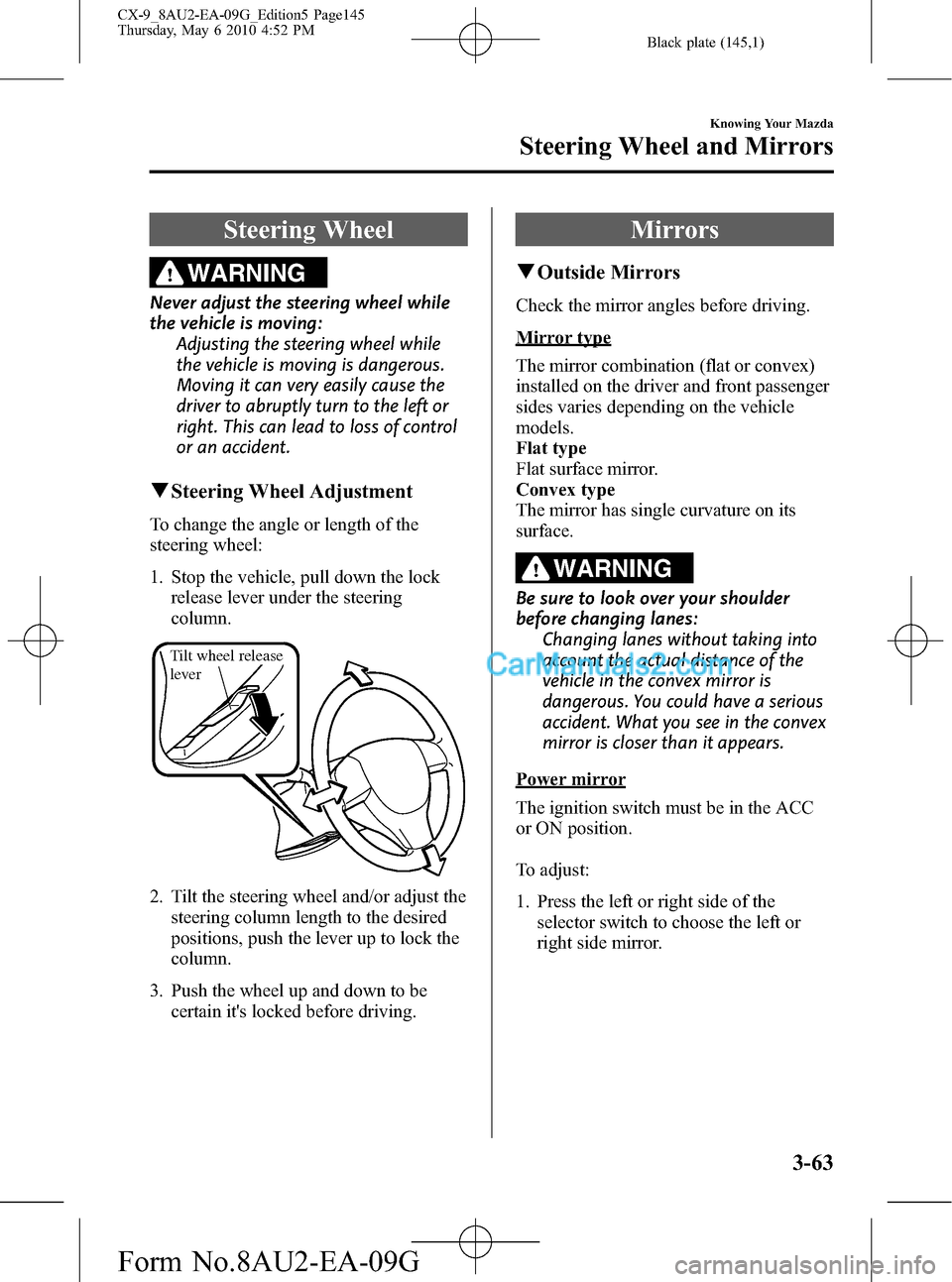
Black plate (145,1)
Steering Wheel
WARNING
Never adjust the steering wheel while
the vehicle is moving:
Adjusting the steering wheel while
the vehicle is moving is dangerous.
Moving it can very easily cause the
driver to abruptly turn to the left or
right. This can lead to loss of control
or an accident.
qSteering Wheel Adjustment
To change the angle or length of the
steering wheel:
1. Stop the vehicle, pull down the lock
release lever under the steering
column.
Tilt wheel release
lever
2. Tilt the steering wheel and/or adjust the
steering column length to the desired
positions, push the lever up to lock the
column.
3. Push the wheel up and down to be
certain it's locked before driving.
Mirrors
qOutside Mirrors
Check the mirror angles before driving.
Mirror type
The mirror combination (flat or convex)
installed on the driver and front passenger
sides varies depending on the vehicle
models.
Flat type
Flat surface mirror.
Convex type
The mirror has single curvature on its
surface.
WARNING
Be sure to look over your shoulder
before changing lanes:
Changing lanes without taking into
account the actual distance of the
vehicle in the convex mirror is
dangerous. You could have a serious
accident. What you see in the convex
mirror is closer than it appears.
Power mirror
The ignition switch must be in the ACC
or ON position.
To adjust:
1. Press the left or right side of the
selector switch to choose the left or
right side mirror.
Knowing Your Mazda
Steering Wheel and Mirrors
3-63
CX-9_8AU2-EA-09G_Edition5 Page145
Thursday, May 6 2010 4:52 PM
Form No.8AU2-EA-09G
Page 167 of 592
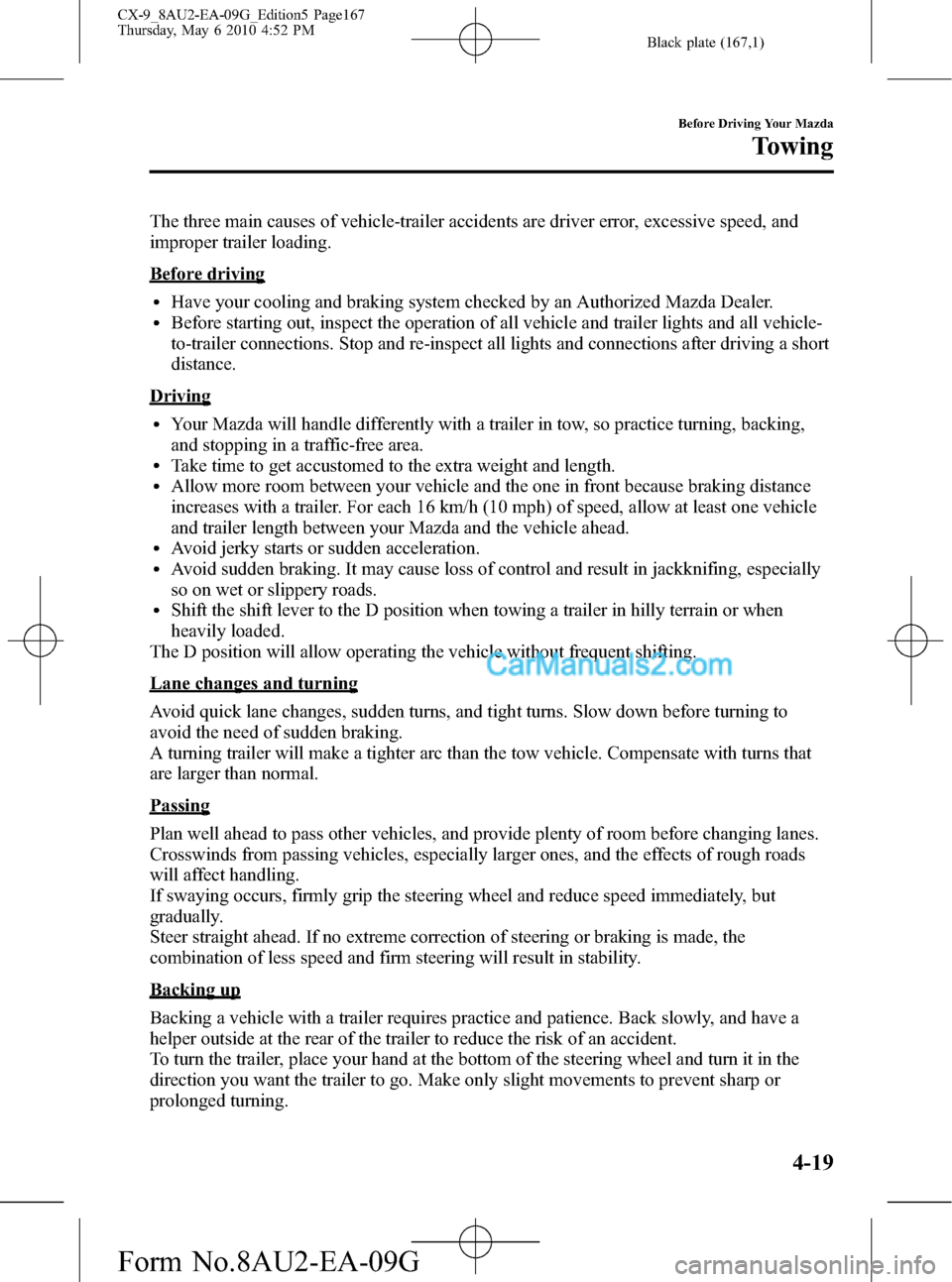
Black plate (167,1)
The three main causes of vehicle-trailer accidents are driver error, excessive speed, and
improper trailer loading.
Before driving
lHave your cooling and braking system checked by an Authorized Mazda Dealer.lBefore starting out, inspect the operation of all vehicle and trailer lights and all vehicle-
to-trailer connections. Stop and re-inspect all lights and connections after driving a short
distance.
Driving
lYour Mazda will handle differently with a trailer in tow, so practice turning, backing,
and stopping in a traffic-free area.
lTake time to get accustomed to the extra weight and length.lAllow more room between your vehicle and the one in front because braking distance
increases with a trailer. For each 16 km/h (10 mph) of speed, allow at least one vehicle
and trailer length between your Mazda and the vehicle ahead.
lAvoid jerky starts or sudden acceleration.lAvoid sudden braking. It may cause loss of control and result in jackknifing, especially
so on wet or slippery roads.
lShift the shift lever to the D position when towing a trailer in hilly terrain or when
heavily loaded.
The D position will allow operating the vehicle without frequent shifting.
Lane changes and turning
Avoid quick lane changes, sudden turns, and tight turns. Slow down before turning to
avoid the need of sudden braking.
A turning trailer will make a tighter arc than the tow vehicle. Compensate with turns that
are larger than normal.
Passing
Plan well ahead to pass other vehicles, and provide plenty of room before changing lanes.
Crosswinds from passing vehicles, especially larger ones, and the effects of rough roads
will affect handling.
If swaying occurs, firmly grip the steering wheel and reduce speed immediately, but
gradually.
Steer straight ahead. If no extreme correction of steering or braking is made, the
combination of less speed and firm steering will result in stability.
Backing up
Backing a vehicle with a trailer requires practice and patience. Back slowly, and have a
helper outside at the rear of the trailer to reduce the risk of an accident.
To turn the trailer, place your hand at the bottom of the steering wheel and turn it in the
direction you want the trailer to go. Make only slight movements to prevent sharp or
prolonged turning.
Before Driving Your Mazda
Towing
4-19
CX-9_8AU2-EA-09G_Edition5 Page167
Thursday, May 6 2010 4:52 PM
Form No.8AU2-EA-09G
Page 334 of 592
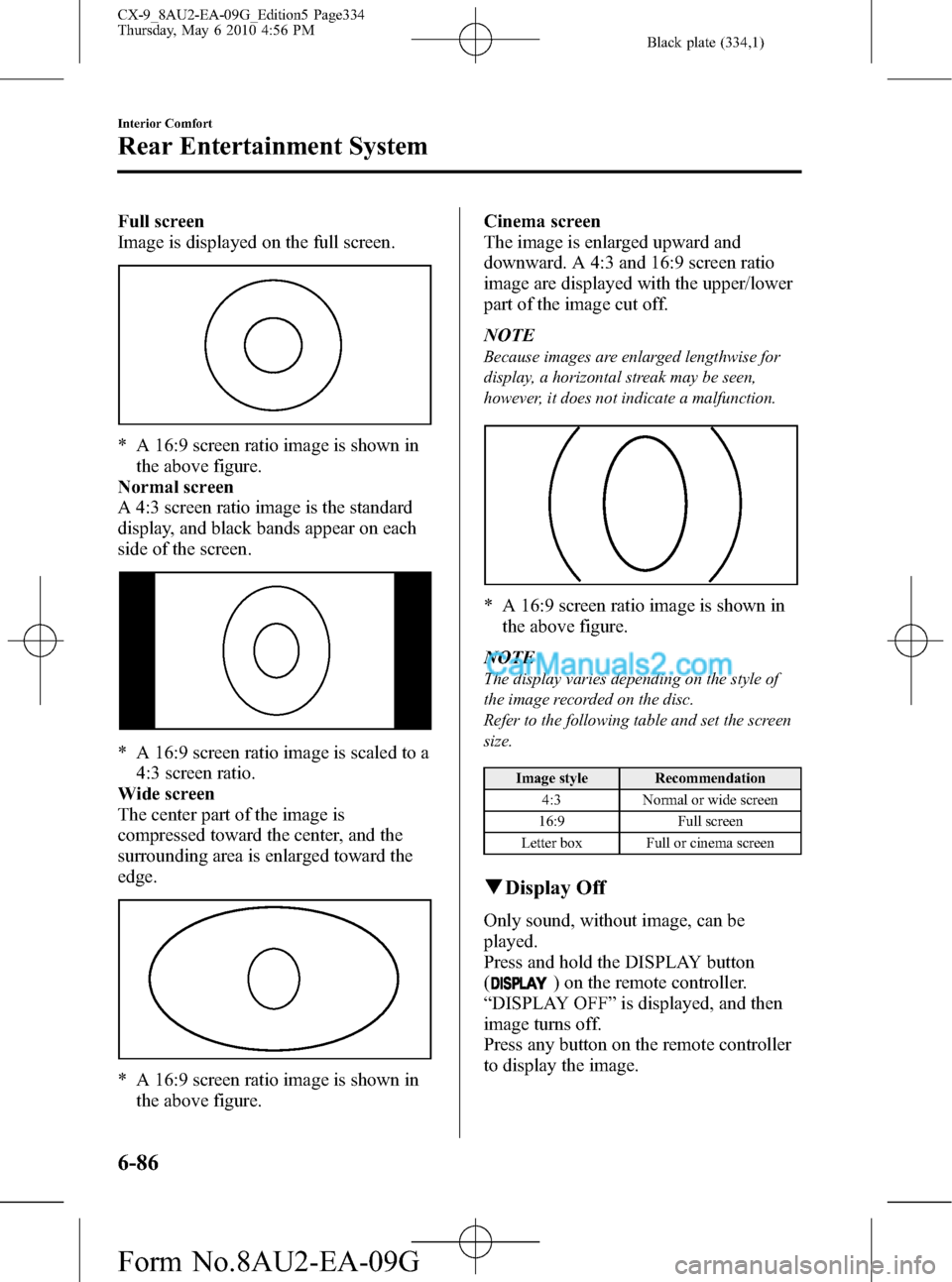
Black plate (334,1)
Full screen
Image is displayed on the full screen.
* A 16:9 screen ratio image is shown in
the above figure.
Normal screen
A 4:3 screen ratio image is the standard
display, and black bands appear on each
side of the screen.
* A 16:9 screen ratio image is scaled to a
4:3 screen ratio.
Wide screen
The center part of the image is
compressed toward the center, and the
surrounding area is enlarged toward the
edge.
* A 16:9 screen ratio image is shown in
the above figure.Cinema screen
The image is enlarged upward and
downward. A 4:3 and 16:9 screen ratio
image are displayed with the upper/lower
part of the image cut off.
NOTE
Because images are enlarged lengthwise for
display, a horizontal streak may be seen,
however, it does not indicate a malfunction.
* A 16:9 screen ratio image is shown in
the above figure.
NOTE
The display varies depending on the style of
the image recorded on the disc.
Refer to the following table and set the screen
size.
Image style Recommendation
4:3 Normal or wide screen
16:9 Full screen
Letter box Full or cinema screen
qDisplay Off
Only sound, without image, can be
played.
Press and hold the DISPLAY button
(
) on the remote controller.
“DISPLAY OFF”is displayed, and then
image turns off.
Press any button on the remote controller
to display the image.
6-86
Interior Comfort
Rear Entertainment System
CX-9_8AU2-EA-09G_Edition5 Page334
Thursday, May 6 2010 4:56 PM
Form No.8AU2-EA-09G
Page 581 of 592
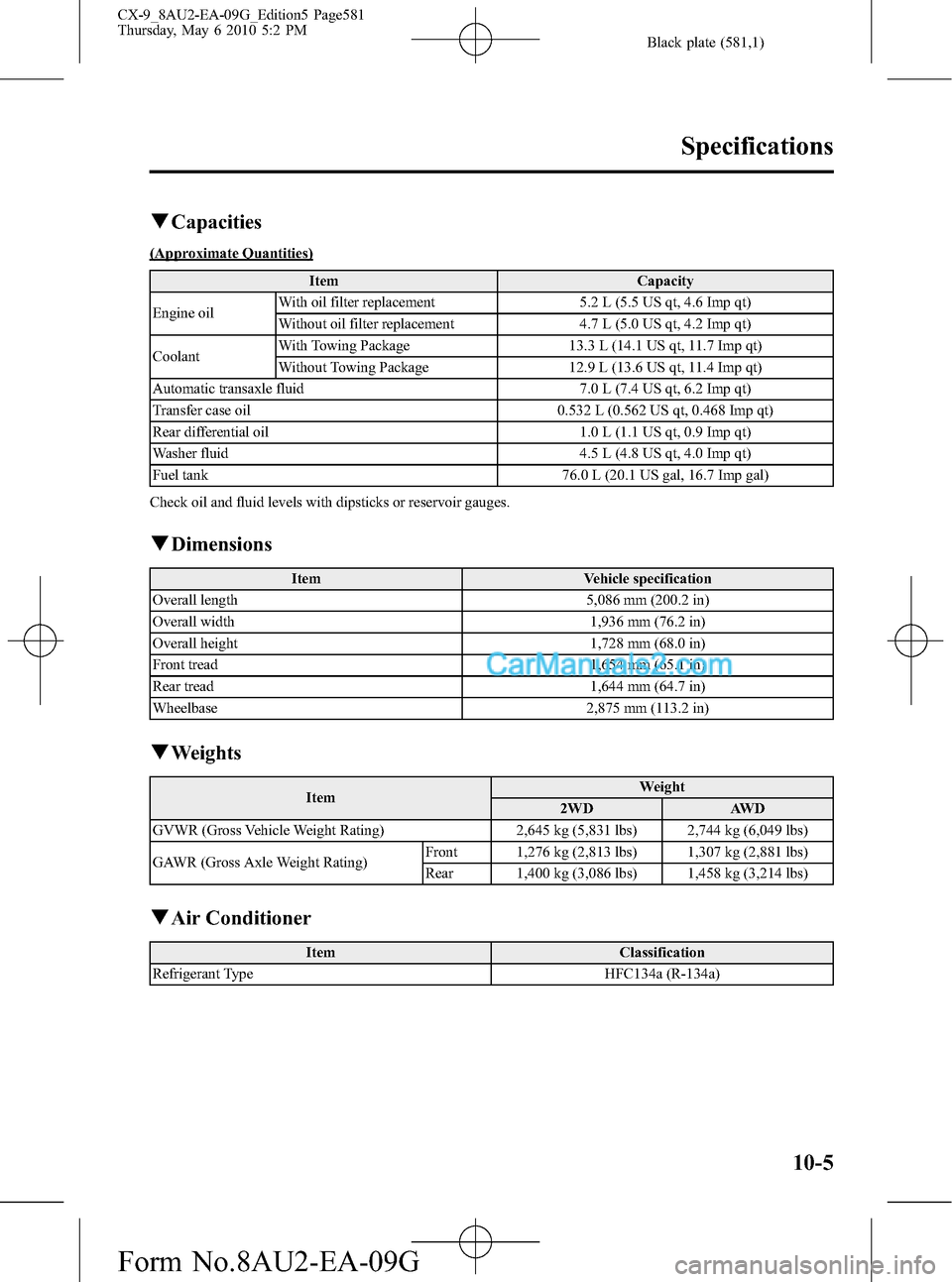
Black plate (581,1)
qCapacities
(Approximate Quantities)
Item Capacity
Engine oilWith oil filter replacement 5.2 L (5.5 US qt, 4.6 Imp qt)
Without oil filter replacement 4.7 L (5.0 US qt, 4.2 Imp qt)
CoolantWith Towing Package 13.3 L (14.1 US qt, 11.7 Imp qt)
Without Towing Package 12.9 L (13.6 US qt, 11.4 Imp qt)
Automatic transaxle fluid 7.0 L (7.4 US qt, 6.2 Imp qt)
Transfer case oil 0.532 L (0.562 US qt, 0.468 Imp qt)
Rear differential oil 1.0 L (1.1 US qt, 0.9 Imp qt)
Washer fluid 4.5 L (4.8 US qt, 4.0 Imp qt)
Fuel tank 76.0 L (20.1 US gal, 16.7 Imp gal)
Check oil and fluid levels with dipsticks or reservoir gauges.
qDimensions
Item Vehicle specification
Overall length 5,086 mm (200.2 in)
Overall width 1,936 mm (76.2 in)
Overall height 1,728 mm (68.0 in)
Front tread 1,654 mm (65.1 in)
Rear tread 1,644 mm (64.7 in)
Wheelbase 2,875 mm (113.2 in)
qWeights
ItemWeight
2WD AWD
GVWR (Gross Vehicle Weight Rating) 2,645 kg (5,831 lbs) 2,744 kg (6,049 lbs)
GAWR (Gross Axle Weight Rating)Front 1,276 kg (2,813 lbs) 1,307 kg (2,881 lbs)
Rear 1,400 kg (3,086 lbs) 1,458 kg (3,214 lbs)
qAir Conditioner
Item Classification
Refrigerant Type HFC134a (R-134a)
Specifications
10-5
CX-9_8AU2-EA-09G_Edition5 Page581
Thursday, May 6 2010 5:2 PM
Form No.8AU2-EA-09G